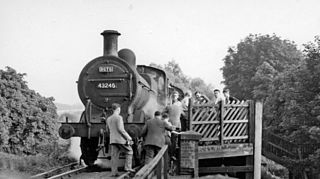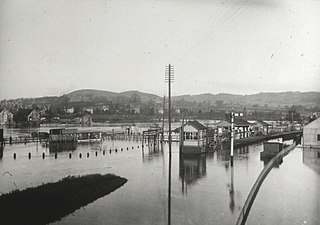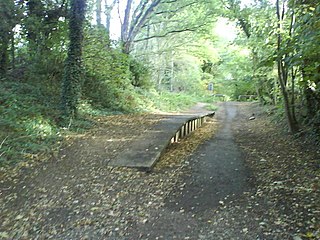
Uxbridge Vine Street station opened on 8 September 1856 as Uxbridge Station and was the earliest of three railway stations in Uxbridge, London.

Uxbridge High Street railway station in Uxbridge, England, was on what is now Oxford Road near its junction with Sanderson Road. It was the southern terminus and only station on the Great Western Railway (GWR) branch line from the GWR/GCR joint line, which is now the Chiltern Main Line.

The Nickey line is a disused railway that once linked the towns of Hemel Hempstead and, initially, Luton but later Harpenden via Redbourn, in Hertfordshire, England. The course of most of the railway has been redeveloped as a cycle and walking path, and is part of the Oxford to Welwyn Garden City route of the National Cycle Network. It is approximately nine miles (14 km) long.

Andover railway station serves the town of Andover, Hampshire, England. The station is served and operated by South Western Railway. It is 66 miles 19 chains (106.6 km) down the line from London Waterloo on the West of England Main Line.

Combe Down Tunnel is on the now-closed Somerset and Dorset Joint Railway main line, between Midford and Bath Green Park railway station, below high ground and the southern suburbs of Bath, England, emerging below the southern slopes of Combe Down village.
South Bromley railway station was a former railway station in South Bromley, London, on the North London Railway between Bow and Poplar. It opened in 1884 but was closed in 1944 after bomb damage in the Blitz cut off the railway east of Dalston Junction.
Tidal Basin railway station was a railway station near the Royal Victoria Dock, Canning Town, London, on the Eastern Counties and Thames Junction Railway. It opened in 1858, and was between Canning Town and Custom House stations. The station was damaged by bomb damage during the Blitz in 1941 but remained open until closed in 1943 as passenger numbers had fallen resulting from the area suffering from severe bombing damage and never reopened. The area was heavily redeveloped following the War, and today no trace remains; its approximate location is south east of Tarling Road, east of the present day footbridge. Royal Victoria DLR station is located approximately 300 yards east.
Limehouse was a railway station in Limehouse, London, on the London and Blackwall Railway (LBR).
Connaught Road was a railway station in east London that was opened by the London & St. Katharine Docks Company on 3 August 1880. It was located on Connaught Road, north of the channel joining the Royal Victoria Dock and Royal Albert Dock.
There are 22 disused railway stations in the 75 miles (121 km) between Bristol Temple Meads and Exeter St Davids, 12 of which have structures that can still be seen from passing trains. Most were closed in the 1960s but four of them, especially around Weston-super-Mare, were replaced by stations on new sites. 13 stations remain open on the line today, but there have been proposals to reopen stations at Cullompton and Wellington.

The Lea Valley Walk is a 50-mile (80 km) long-distance path located between Leagrave, the source of the River Lea near Luton, and the Thames, at Limehouse Basin, Limehouse, east London. From its source much of the walk is rural. At Hertford the path follows the towpath of the River Lee Navigation, and it becomes increasingly urbanised as it approaches London. The walk was opened in 1993 and is waymarked throughout using a swan logo.

Cirencester Watermoor railway station was on the Midland and South Western Junction Railway (M&SWJR) at Cirencester in Gloucestershire. The station opened on 18 December 1883, as the terminus of the Swindon and Cheltenham Extension Railway line from Swindon Town. That line then amalgamated with the Swindon, Marlborough and Andover Railway to form the M&SWJR. Cirencester became a through-station in 1891, with the opening of the northern extension of the line between Cirencester and the junction at Andoversford with the Great Western Railway (GWR)'s Cheltenham Lansdown to Banbury line, which had opened in 1881.

Old Kent Road was a railway station on the London, Brighton and South Coast Railway line in south London. It took its name from the Old Kent Road on which it was located.
Lewes Road railway station was a railway station in Brighton, East Sussex. It was located on the now closed Kemp Town branch line which first opened in 1869. The station opened on 1 September 1873 and was closed to passengers in 1933 but the line remained opened for goods trains until 1971.

Smallford railway station was a station on the former St Albans Branch Line in the UK. The station opened as Springfield in 1866, and was renamed in 1879. The station closed permanently on New Year's Day 1969 when a haulage contract ended with a local scrap merchant, but it had already closed to passengers in 1951. The single platform still exists alongside the Alban Way rail trail, as does the ticket office, located in an adjacent builders' yard. The current Station Yard and Station Road mark the location of the station on what is now the Alban Way.

Ash Green Halt railway station known for a time as Ash Green, served the village of Ash, Surrey in England on the original route of the Alton Line which ran from London via the town of Guildford to the east.

The Dunstable Branch Lines were railway branch lines that joined the English town of Dunstable to the main lines at Leighton Buzzard and Welwyn. The two lines were under separate ownership and joined just east of the Dunstable North station.

Wheathampstead railway station was a railway station serving Wheathampstead on the Great Northern Railway branch line to Dunstable. While little of it remains now, east of Wheathampstead is the Ayot Greenway which follows what was the line towards Welwyn Garden City.

Monmouth Mayhill railway station is a disused railway station on the Ross and Monmouth Railway which was opened in 1873 and closed in 1959. It was one of two stations that served the town of Monmouth, Wales and was situated on the opposite bank of the river River Wye from Monmouth. It was the initial terminus of the line, but the line was extended across the River Wye to the junction station of Monmouth Troy in 1874 with the construction of the Duke of Beaufort Bridge.

Roundwood Halt railway station co-served the town of Harpenden, Hertfordshire, England from 1927 to 1949 on the Nickey Line.













